Voltammetric Electronic Tongue for the Simultaneous Determination of Three Benzodiazepines
Abstract
:1. Introduction
2. Materials and Methods.
2.1. Chemicals and Reagents
2.2. Preparation of the Modified Electrodes
2.3. Electronic Tongue
2.4. Model Design and Sample Preparation
2.5. Data Processing
3. Results
3.1. Voltammetric Array Response
3.2. Quantitative Analysis: Artificial Neural Network Modeling
4. Conclusions
Author Contributions
Funding
Acknowledgments
Conflicts of Interest
References
- Persona, K.; Madej, K.; Knihnicki, P.; Piekoszewski, W. Analytical methodologies for the determination of benzodiazepines in biological samples. J. Pharm. Biomed. Anal. 2015, 113, 239–264. [Google Scholar] [CrossRef]
- Lévi, S.; Le Roux, N.; Eugène, E.; Poncer, J.C. Benzodiazepine ligands rapidly influence GABAA receptor diffusion and clustering at hippocampal inhibitory synapses. Neuropharmacology 2015, 88, 199–208. [Google Scholar] [CrossRef] [PubMed]
- Ariffin, M.M.; Miller, E.I.; Cormack, P.A.G.; Anderson, R.A. Molecularly imprinted solid-phase extraction of diazepam and its metabolites from hair samples. Anal. Chem. 2007, 79, 256–262. [Google Scholar] [CrossRef] [PubMed]
- Uddin, M.N.; Samanidou, V.F.; Papadoyannis, I.N. Development and validation of an HPLC method for the determination of six 1,4-benzodiazepines in pharmaceuticals and human biological fluids. J. Liq. Chromatogr. Relat. Technol. 2008, 31, 1258–1282. [Google Scholar] [CrossRef]
- Anderson, R.A.; Ariffin, M.M.; Cormack, P.A.G.; Miller, E.I. Comparison of molecularly imprinted solid-phase extraction (MISPE) with classical solid-phase extraction (SPE) for the detection of benzodiazepines in post-mortem hair samples. Forensic Sci. Int. 2008, 174, 40–46. [Google Scholar] [CrossRef] [PubMed]
- Dziadosz, M.; Teske, J.; Henning, K.; Klintschar, M.; Nordmeier, F. LC–MS/MS screening strategy for cannabinoids, opiates, amphetamines, cocaine, benzodiazepines and methadone in human serum, urine and post-mortem blood as an effective alternative to immunoassay based methods applied in forensic toxicology for preliminary. Forensic Chem. 2018, 7, 33–37. [Google Scholar] [CrossRef]
- Riahi, S.; Bagherzadeh, K.; Davarkhah, N.; Ganjali, M.R.; Norouzi, P. Spectrophotometric and chemometric studies on the simultaneous determination of two benzodiazepines in human plasma. Mater. Sci. Eng. C 2011, 31, 992–996. [Google Scholar] [CrossRef]
- Furlanetto, S.; Orlandini, S.; Massolini, G.; Faucci, M.T.; La Porta, E.; Pinzauti, S. Optimisation and validation of a capillary electrophoresis method for the simultaneous determination of diazepam and otilonium bromide. Analyst 2001, 126, 1700–1706. [Google Scholar] [CrossRef]
- Piergiovanni, M.; Cappiello, A.; Famiglini, G.; Termopoli, V.; Palma, P. Determination of benzodiazepines in beverages using green extraction methods and capillary HPLC-UV detection. J. Pharm. Biomed. Anal. 2018, 154, 492–500. [Google Scholar] [CrossRef]
- Pettersson Bergstrand, M.; Helander, A.; Beck, O. Development and application of a multi-component LC–MS/MS method for determination of designer benzodiazepines in urine. J. Chromatogr. B Anal. Technol. Biomed. Life Sci. 2016, 1035, 104–110. [Google Scholar] [CrossRef]
- Dickson, S.; Park, A.; Nolan, S.; Kenworthy, S.; Nicholson, C.; Midgley, J.; Pinfold, R.; Hampton, S. The recovery of illicit drugs from oral fluid sampling devices. Forensic Sci. Int. 2007, 165, 78–84. [Google Scholar] [CrossRef] [PubMed]
- Bertol, E.; Vaiano, F.; Furlanetto, S.; Mari, F. Cross-reactivities and structure-reactivity relationships of six benzodiazepines to EMIT® immunoassay. J. Pharm. Biomed. Anal. 2013, 84, 168–172. [Google Scholar] [CrossRef] [PubMed]
- Honeychurch, K.C.; Brooks, J.; Hart, J.P. Development of a voltammetric assay, using screen-printed electrodes, for clonazepam and its application to beverage and serum samples. Talanta 2016, 147, 510–515. [Google Scholar] [CrossRef] [PubMed]
- Jain, R.; Sinha, A.; Kumari, N.; Khan, A.L. A polyaniline/graphene oxide nanocomposite as a voltammetric sensor for electroanalytical detection of clonazepam. Anal. Methods 2016, 8, 3034–3045. [Google Scholar] [CrossRef]
- Majidi, M.R.; Ghaderi, S.; Asadpour-Zeynali, K.; Dastangoo, H. Synthesis of dendritic silver nanostructures supported by graphene nanosheets and its application for highly sensitive detection of diazepam. Mater. Sci. Eng. C 2015, 57, 257–264. [Google Scholar] [CrossRef]
- Honeychurch, K.C.; Crew, A.; Northall, H.; Radbourne, S.; Davies, O.; Newman, S.; Hart, J.P. The redox behaviour of diazepam (Valium®) using a disposable screen-printed sensor and its determination in drinks using a novel adsorptive stripping voltammetric assay. Talanta 2013, 116, 300–307. [Google Scholar] [CrossRef]
- Rahimi-Nasrabadi, M.; Khoshroo, A.; Mazloum-Ardakani, M. Electrochemical determination of diazepam in real samples based on fullerene-functionalized carbon nanotubes/ionic liquid nanocomposite. Sens. Actuators B Chem. 2017, 240, 125–131. [Google Scholar] [CrossRef]
- Rezaei, B.; Boroujeni, M.K.; Ensafi, A.A. A novel electrochemical nanocomposite imprinted sensor for the determination of lorazepam based on modified polypyrrole@sol-gel@gold nanoparticles/pencil graphite electrode. Electrochim. Acta 2014, 123, 332–339. [Google Scholar] [CrossRef]
- Mohammadi-Behzad, L.; Gholivand, M.B.; Shamsipur, M.; Gholivand, K.; Barati, A.; Gholami, A. Highly sensitive voltammetric sensor based on immobilization of bisphosphoramidate-derivative and quantum dots onto multi-walled carbon nanotubes modified gold electrode for the electrocatalytic determination of olanzapine. Mater. Sci. Eng. C 2016, 60, 67–77. [Google Scholar] [CrossRef]
- Garcia-Gutierrez, E.; Lledo-Fernandez, C. Electroanalytical sensing of Flunitrazepam based on screen printed graphene electrodes. Chemosensors 2013, 1, 68–77. [Google Scholar] [CrossRef]
- Tseliou, F.; Pappas, P.; Spyrou, K.; Hrbac, J.; Prodromidis, M.I. Lab-On-A-Screen-Printed electrochemical cell for drop-volume voltammetric screening of flunitrazepam in untreated, undiluted alcoholic and soft drinks. Biosens. Bioelectron. 2019, 132, 136–142. [Google Scholar] [CrossRef] [PubMed]
- Lozano-Chaves, M.E.; Palacios-Santander, J.M.; Cubillana-Aguilera, L.M.; Naranjo-Rodríguez, I.; Hidalgo-Hidalgo-de-Cisneros, J.L. Modified carbon-paste electrodes as sensors for the determination of 1,4-benzodiazepines: Application to the determination of diazepam and oxazepam in biological fluids. Sens. Actuators B Chem. 2006, 115, 575–583. [Google Scholar] [CrossRef]
- Zare, M.A.; Tehrani, M.S.; Husain, S.W.; Azar, P.A. Multiwall carbon nanotube-ionic liquid modified paste electrode as an efficient sensor for the determination of diazepam and oxazepam in real samples. Electroanalysis 2014, 26, 2599–2606. [Google Scholar] [CrossRef]
- Samiec, P.; Švorc, L.; Stanković, D.M.; Vojs, M.; Marton, M.; Navrátilová, Z. Mercury-Free and modification-free electroanalytical approach towards bromazepam and alprazolam sensing: A facile and efficient assay for their quantification in pharmaceuticals using boron-doped diamond electrodes. Sens. Actuators B Chem. 2017, 245, 963–971. [Google Scholar] [CrossRef]
- Merli, D.; Dondi, D.; Pesavento, M.; Profumo, A. Electrochemistry of olanzapine and risperidone at carbon nanotubes modified gold electrode through classical and DFT approaches. J. Electroanal. Chem. 2012, 683, 103–111. [Google Scholar] [CrossRef]
- Naggar, A.H.; Elkaoutit, M.; Naranjo-Rodriguez, I.; El-Sayed, A.E.A.Y.; De Cisneros, J.L.H.H. Use of a Sonogel-Carbon electrode modified with bentonite for the determination of diazepam and chlordiazepoxide hydrochloride in tablets and their metabolite oxazepam in urine. Talanta 2012, 89, 448–454. [Google Scholar] [CrossRef]
- Ashrafi, H.; Mobed, A.; Hasanzadeh, M.; Babaie, P.; Ansarin, K.; Jouyban, A. Monitoring of five benzodiazepines using a novel polymeric interface prepared by layer by layer strategy. Microchem. J. 2019, 146, 121–125. [Google Scholar] [CrossRef]
- Dos Santos, M.M.C.; Famila, V.; Gonçalves, M.L.S. Square-Wave voltammetric techniques for determination of psychoactive 1,4-benzodiazepine drugs. Anal. Bioanal. Chem. 2002, 374, 1074–1081. [Google Scholar] [CrossRef]
- Ashrafi, H.; Hassanpour, S.; Saadati, A.; Hasanzadeh, M.; Ansarin, K.; Ozkan, S.A.; Shadjou, N.; Jouyban, A. Sensitive detection and determination of benzodiazepines using silver nanoparticles-N-GQDs ink modified electrode: A new platform for modern pharmaceutical analysis. Microchem. J. 2019, 145, 1050–1057. [Google Scholar] [CrossRef]
- Samiec, P.; Navrátilová, Z.; Fischer, J. Voltammetry of benzodiazepines on meniscus-modified silver solid amalgam electrode. Mon. Chem. 2016, 147, 127–134. [Google Scholar] [CrossRef]
- Moreno-Barón, L.; Cartas, R.; Merkoçi, A.; Alegret, S.; Gutiérrez, J.M.; Leija, L.; Hernandez, P.R.; Muñoz, R.; del Valle, M. Data compression for a voltammetric electronic tongue modelled with artificial neural networks. Anal. Lett. 2005, 38, 2189–2206. [Google Scholar] [CrossRef]
- Dias, L.G.; Fernandes, A.; Veloso, A.C.A.; Machado, A.A.S.C.; Pereira, J.A.; Peres, A.M. Single-cultivar extra virgin olive oil classification using a potentiometric electronic tongue. Food Chem. 2014, 160, 321–329. [Google Scholar] [CrossRef] [PubMed] [Green Version]
- Ciosek, P.; Wróblewski, W. Potentiometric electronic tongues for foodstuff and biosample recognition-an overview. Sensors 2011, 11, 4688–4701. [Google Scholar] [CrossRef] [PubMed] [Green Version]
- Scampicchio, M.; Benedetti, S.; Brunetti, B.; Mannino, S. Amperometric electronic tongue for the evaluation of the tea astringency. Electroanalysis 2006, 18, 1643–1648. [Google Scholar] [CrossRef]
- Pioggia, G.; Di Francesco, F.; Ferro, M.; Sorrentino, F.; Salvo, P.; Ahluwalia, A. Characterization of a carbon nanotube polymer composite sensor for an impedimetric electronic tongue. Microchim. Acta 2008, 163, 57–62. [Google Scholar] [CrossRef]
- Cortina-Puig, M.; Muñoz-Berbel, X.; Alonso-Lomillo, M.A.; Muñoz-Pascual, F.J.; del Valle, M. EIS multianalyte sensing with an automated SIA system—An electronic tongue employing the impedimetric signal. Talanta 2007, 72, 774–779. [Google Scholar] [CrossRef] [PubMed]
- Braga, G.S.; Paterno, L.G.; Fonseca, F.J. Performance of an electronic tongue during monitoring 2-methylisoborneol and geosmin in water samples. Sens. Actuators B Chem. 2012, 171, 181–189. [Google Scholar] [CrossRef]
- Arrieta, Á.A.; Rodríguez-Méndez, M.L.; de Saja, J.A.; Blanco, C.A.; Nimubona, D. Prediction of bitterness and alcoholic strength in beer using an electronic tongue. Food Chem. 2010, 123, 642–646. [Google Scholar] [CrossRef]
- Lvova, L.; Yaroshenko, I.; Kirsanov, D.; Di Natale, C.; Paolesse, R.; Legin, A. Electronic tongue for brand uniformity control: A case study of apulian red wines recognition and defects evaluation. Sensors 2018, 18, 2584. [Google Scholar] [CrossRef] [Green Version]
- Cetó, X.; González-Calabuig, A.; Crespo, N.; Pérez, S.; Capdevila, J.; Puig-Pujol, A.; del Valle, M. Electronic tongues to assess wine sensory descriptors. Talanta 2017, 162, 218–224. [Google Scholar] [CrossRef]
- González-Calabuig, A.; Cetó, X.; del Valle, M. Electronic tongue for nitro and peroxide explosive sensing. Talanta 2016, 153, 340–346. [Google Scholar] [CrossRef] [PubMed]
- Pérez-Ràfols, C.; Gómez, A.; Serrano, N.; Díaz-Cruz, J.M.; Ariño, C.; Esteban, M. A voltammetric electronic tongue based on commercial screen-printed electrodes for the analysis of aminothiols by differential pulse voltammetry. Electroanalysis 2017, 29, 1559–1565. [Google Scholar] [CrossRef]
- Herrera-Chacon, A.; González-Calabuig, A.; Campos, I.; del Valle, M. Bioelectronic tongue using MIP sensors for the resolution of volatile phenolic compounds. Sens. Actuators B Chem. 2018, 258, 665–671. [Google Scholar] [CrossRef]
- González-Calabuig, A.; del Valle, M. Voltammetric electronic tongue to identify Brett character in wines: On-Site quantification of its ethylphenol metabolites. Talanta 2018, 179, 70–74. [Google Scholar] [CrossRef]
- Faura, G.; González-Calabuig, A.; del Valle, M. Analysis of amino acid mixtures by voltammetric electronic tongues and artificial neural networks. Electroanalysis 2016, 28, 1894–1900. [Google Scholar] [CrossRef]
- Cetó, X.; Apetrei, C.; del Valle, M.; Rodríguez-Méndez, M.L. Evaluation of red wines antioxidant capacity by means of a voltammetric e-tongue with an optimized sensor array. Electrochim. Acta 2014, 120, 180–186. [Google Scholar] [CrossRef]
- Gutiérrez, J.M.; Haddi, Z.; Amari, A.; Bouchikhi, B.; Mimendia, A.; Cetó, X.; del Valle, M. Hybrid electronic tongue based on multisensor data fusion for discrimination of beers. Sens. Actuators B Chem. 2013, 177, 989–996. [Google Scholar] [CrossRef] [Green Version]
- Cetó, X.; Gutiérrez, J.M.; Moreno-Barón, L.; Alegret, S.; del Valle, M. Voltammetric electronic tongue in the analysis of cava wines. Electroanalysis 2011, 23, 72–78. [Google Scholar] [CrossRef]
- Pein, M.; Kirsanov, D.; Ciosek, P.; del Valle, M.; Yaroshenko, I.; Wesoły, M.; Zabadaj, M.; Gonzalez-Calabuig, A.; Wróblewski, W.; Legin, A. Independent comparison study of six different electronic tongues applied for pharmaceutical analysis. J. Pharm. Biomed. Anal. 2015, 114, 321–329. [Google Scholar] [CrossRef] [Green Version]
- European Directorate for the Quality of Medicines & Healthcare. Ch. 8.7 Chemometric Methods Applied to Analytical Data. In European Pharmacopoeia, 9th ed.; Council of Europe: Strasbourg, France, 2016. [Google Scholar]
- Calvo, D.; Durán, A.; del Valle, M. Use of sequential injection analysis to construct an electronic-tongue. Application to multidetermination employing the transient response of a potentiometric sensor array. Anal. Chim. Acta 2007, 600, 97–104. [Google Scholar] [CrossRef]
- Cetó, X.; Céspedes, F.; Pividori, M.I.; Gutiérrez, J.M.; del Valle, M. Resolution of phenolic antioxidant mixtures employing a voltammetric bio-electronic tongue. Analyst 2012, 137, 349–356. [Google Scholar] [CrossRef] [PubMed]
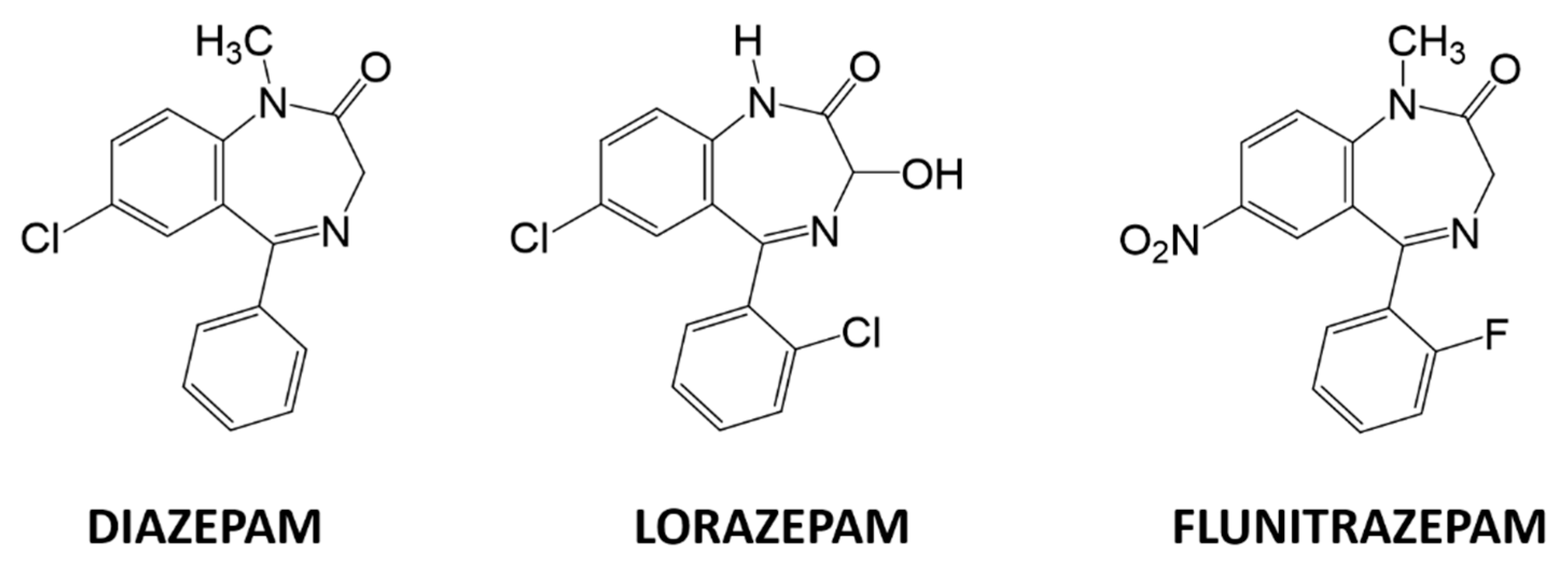

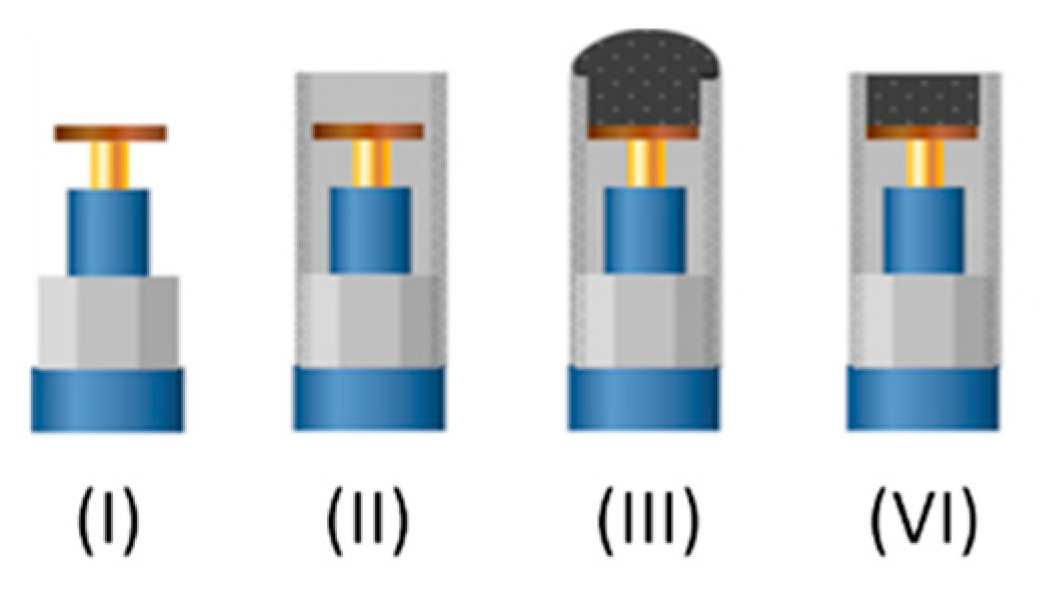

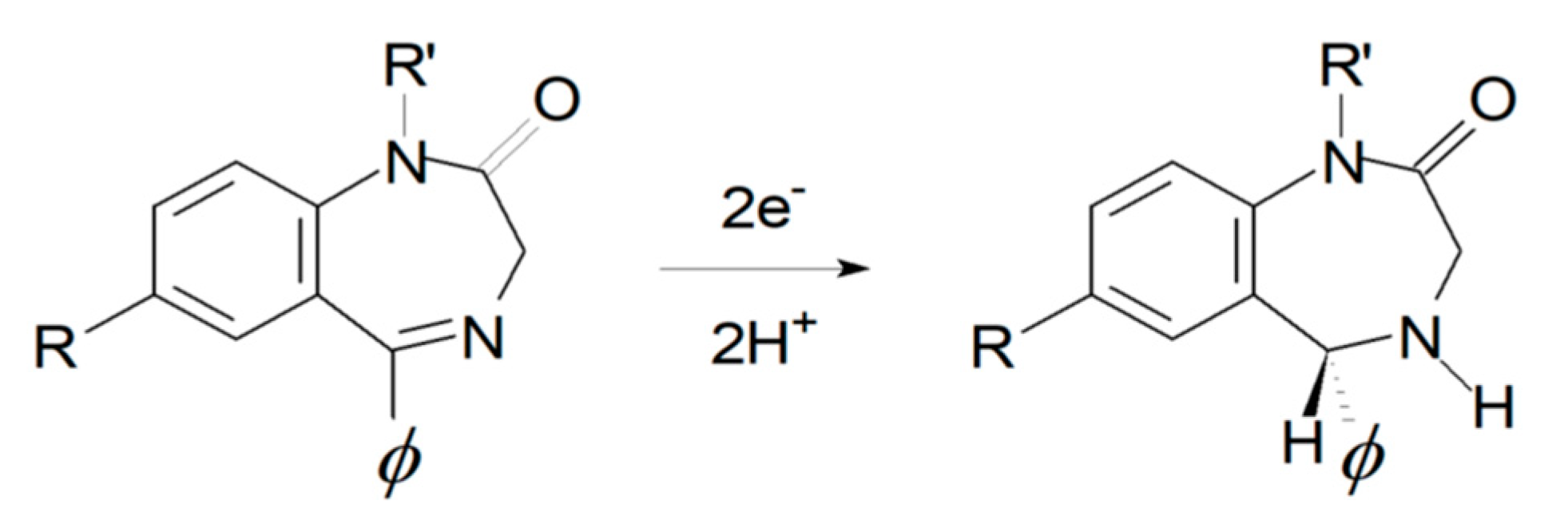
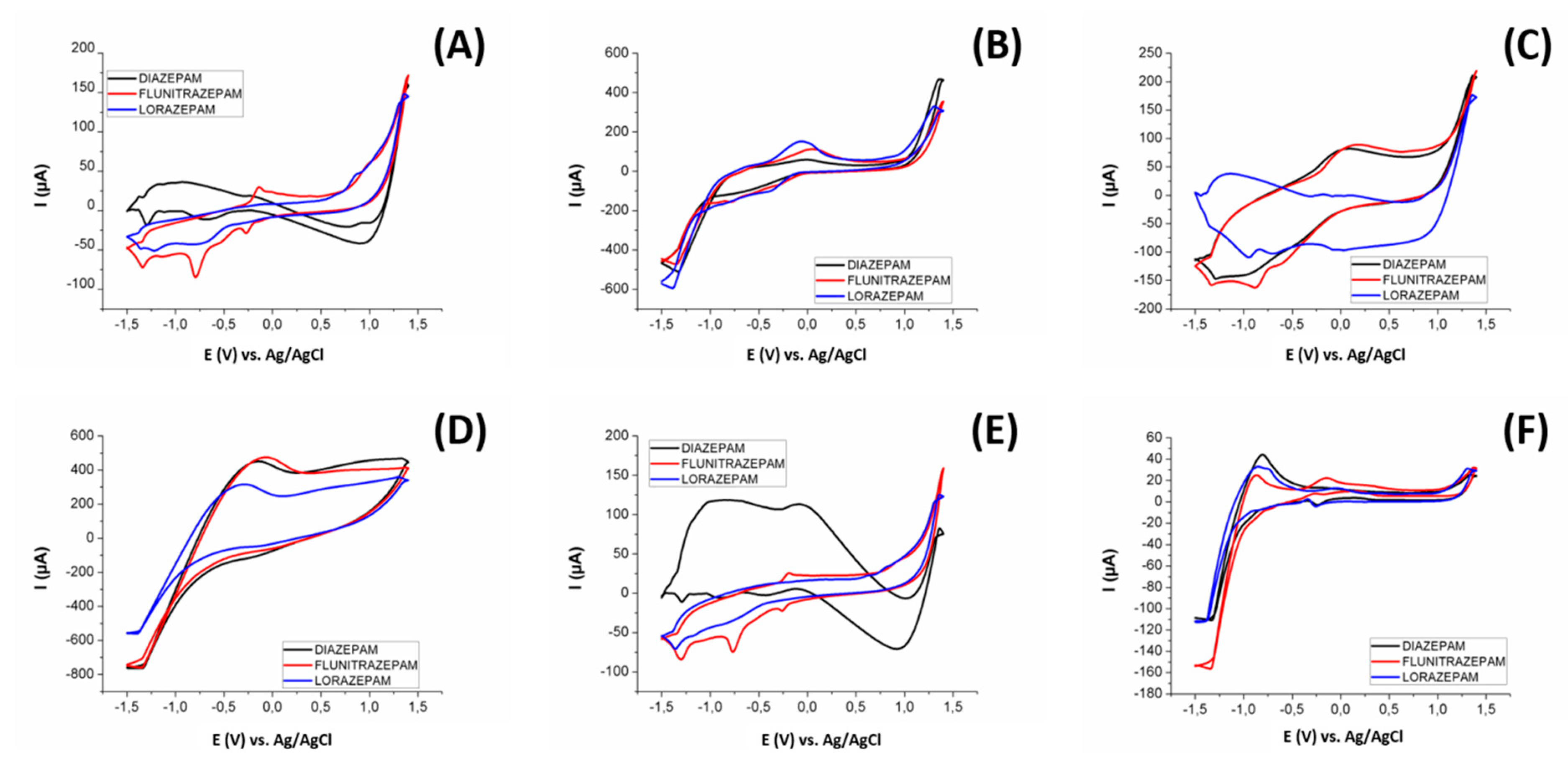
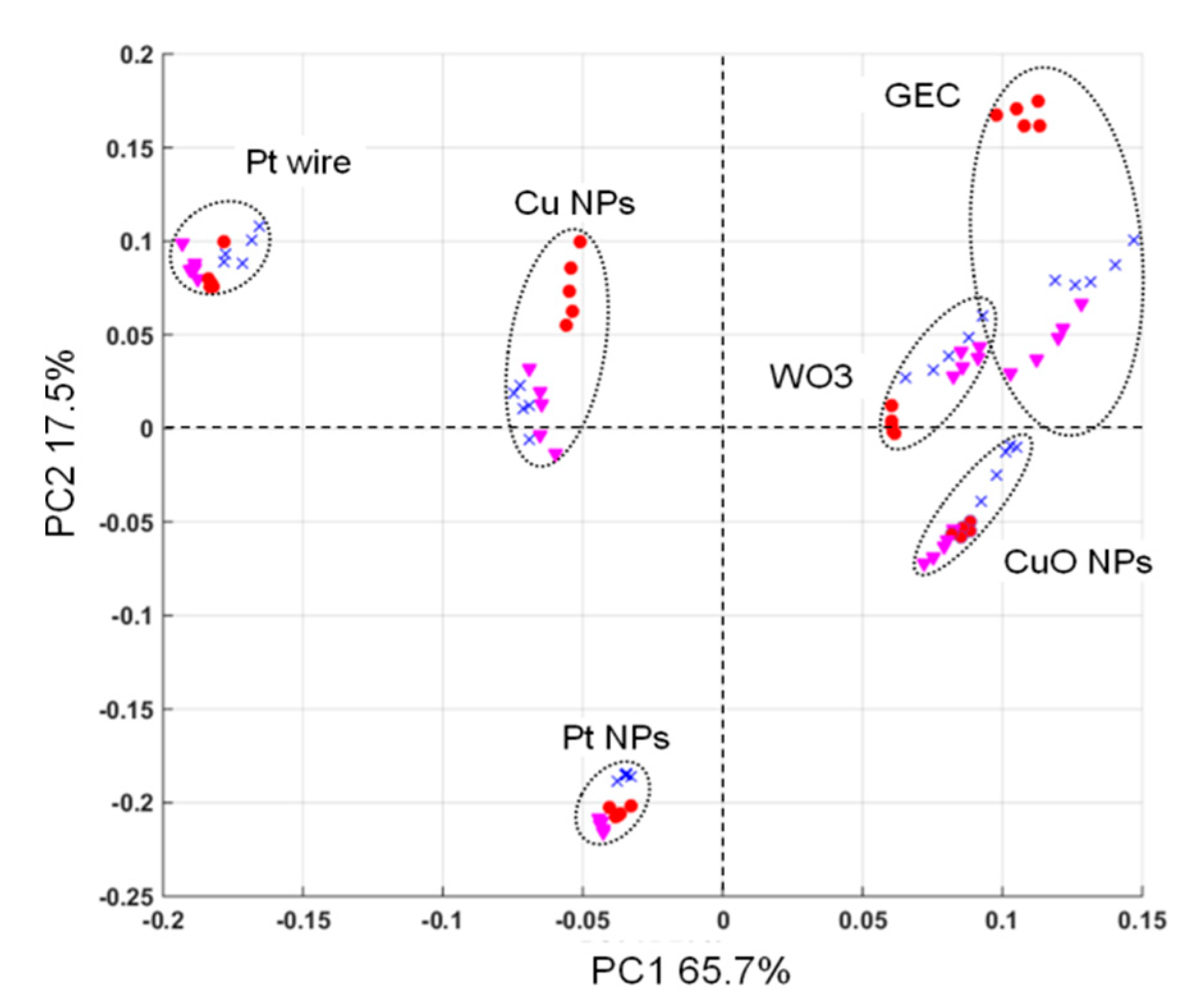
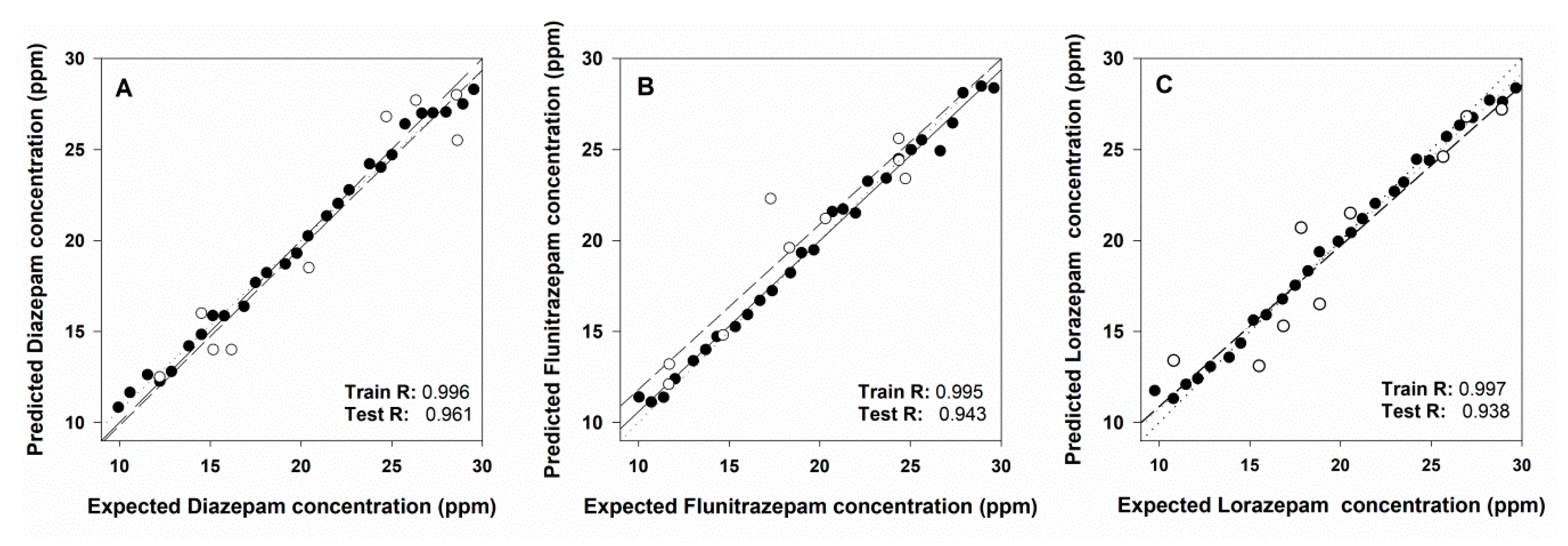
| Set | Analyte | R2 | Slope | Intercept (ppm) | NRMSE | Combined NRMSE |
|---|---|---|---|---|---|---|
| Training Set (n = 27) | Diazepam | 0.996 | 0.932 | 1.358 | 0.035 | |
| Flunitrazepam | 0.996 | 0.939 | 1.196 | 0.034 | 0.034 | |
| Lorazepam | 0.997 | 0.923 | 1.498 | 0.034 | ||
| Testing Set (n = 9) | Diazepam | 0.961 | 0.977 | 0.075 | 0.105 | |
| Flunitrazepam | 0.943 | 0.909 | 2.714 | 0.113 | 0.106 | |
| Lorazepam | 0.938 | 0.884 | 2.044 | 0.114 |
| Substances. | Electrode | Technique | Lineal Range (M) | Limit of Detection (µM) | Reference |
|---|---|---|---|---|---|
| Diazepam | Ag nanodendrimers supported by graphene nanosheets modified glassy carbon electrode | Differential pulse voltammetry | 1.0 × 10−7–1.0 × 10−6 | 0.086 | [15] |
| Diazepam | Unmodified SPCE | Differential pulse adsorptive stripping voltammetry | 2.5 × 10−5–1 × 10−3 | 6.3 | [16] |
| Diazepam | Fullerene functionalized carbon nanotubes/ionic liquidnanocomposite GCE | Differential pulse voltammetry | 0.3 × 10−6–7 × 10−4 | 0.0087 | [17] |
| Diazepam | Multiwall Carbon Nanotube-Ionic Liquid Modified Paste Electrode | Square wave voltammetry | 7 × 10−8–2.5 × 10−6 | 0.014 | [23] |
| Lorazepam | Modified polypyrrole@sol-gel@gold nanoparticles/pencil graphite electrode | Cyclic voltammetry | 0.2 × 10−9–2 × 10−9 | 0.0009 | [18] |
| Flunitrazepam | SPGE | Cyclic voltammetry | 3.2 × 10−8–6.4 × 10−7 | 0.019 | [20] |
| Diazepam Flunitrazepam Lorazepam | Metal nanoparticle modified graphite epoxy sensor array | Cyclic voltammetry–Electronic tongue | 3.5 × 10−5–1.1 × 10−4 3.2 × 10−5–9.6 × 10−4 3.1 × 10−5–9.3 × 10−5 | 6.0 5.6 4.6 | This work |
© 2019 by the authors. Licensee MDPI, Basel, Switzerland. This article is an open access article distributed under the terms and conditions of the Creative Commons Attribution (CC BY) license (http://creativecommons.org/licenses/by/4.0/).
Share and Cite
Herrera-Chacón, A.; Torabi, F.; Faridbod, F.; Ghasemi, J.B.; González-Calabuig, A.; del Valle, M. Voltammetric Electronic Tongue for the Simultaneous Determination of Three Benzodiazepines. Sensors 2019, 19, 5002. https://doi.org/10.3390/s19225002
Herrera-Chacón A, Torabi F, Faridbod F, Ghasemi JB, González-Calabuig A, del Valle M. Voltammetric Electronic Tongue for the Simultaneous Determination of Three Benzodiazepines. Sensors. 2019; 19(22):5002. https://doi.org/10.3390/s19225002
Chicago/Turabian StyleHerrera-Chacón, Anna, Farzad Torabi, Farnoush Faridbod, Jahan B. Ghasemi, Andreu González-Calabuig, and Manel del Valle. 2019. "Voltammetric Electronic Tongue for the Simultaneous Determination of Three Benzodiazepines" Sensors 19, no. 22: 5002. https://doi.org/10.3390/s19225002





